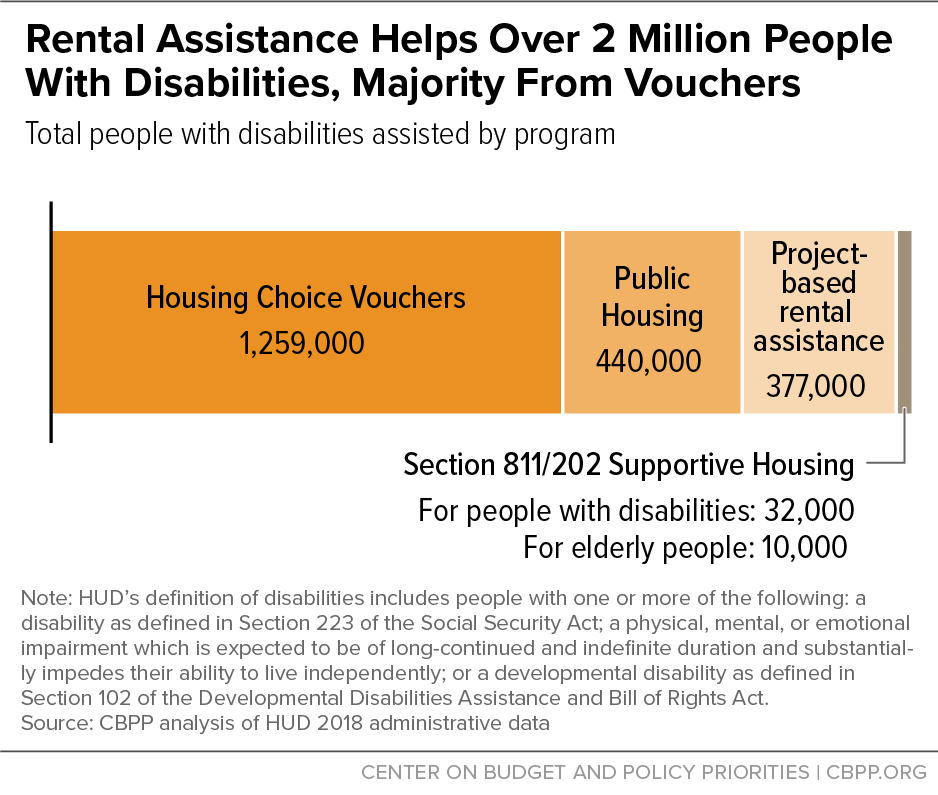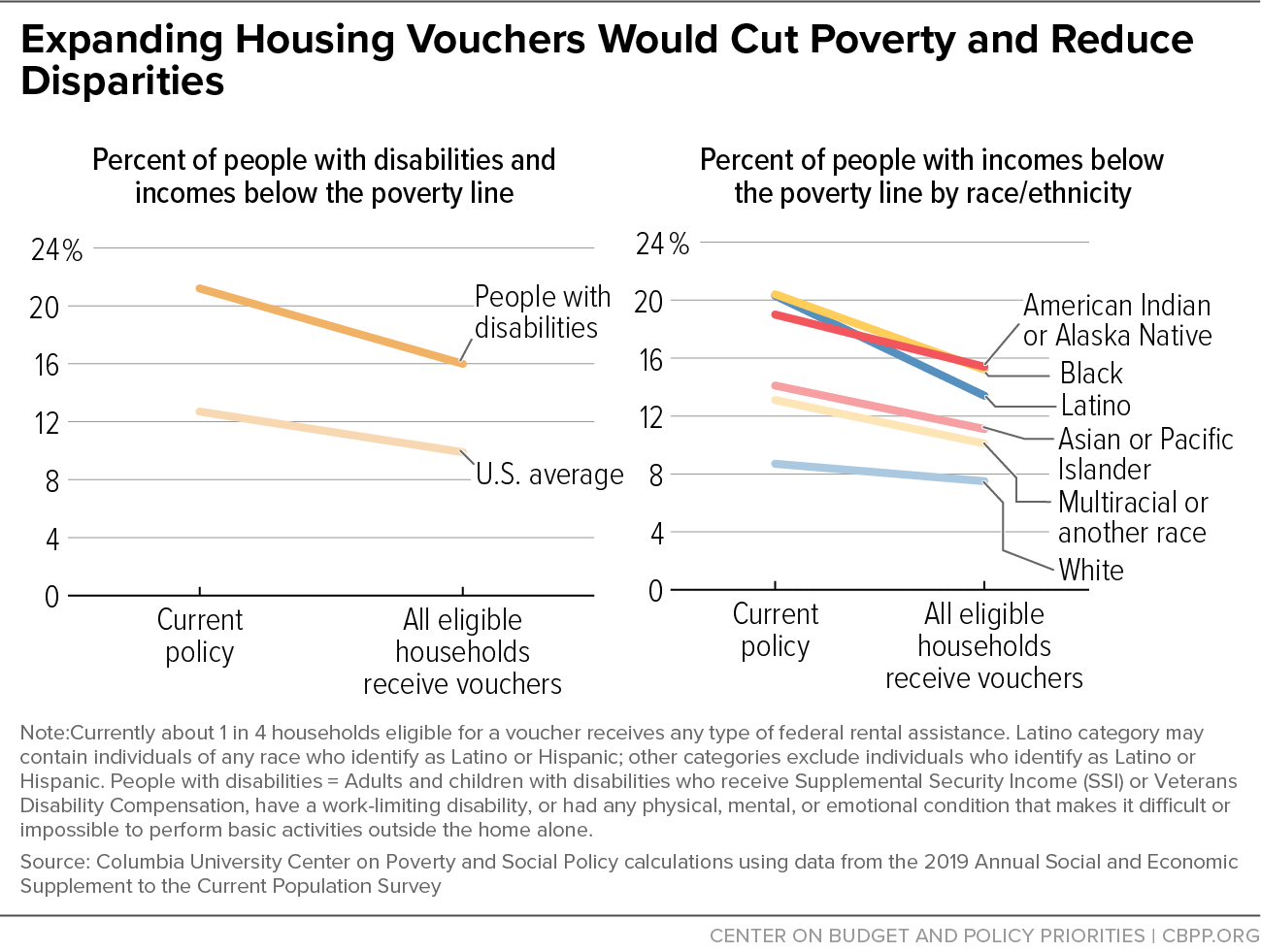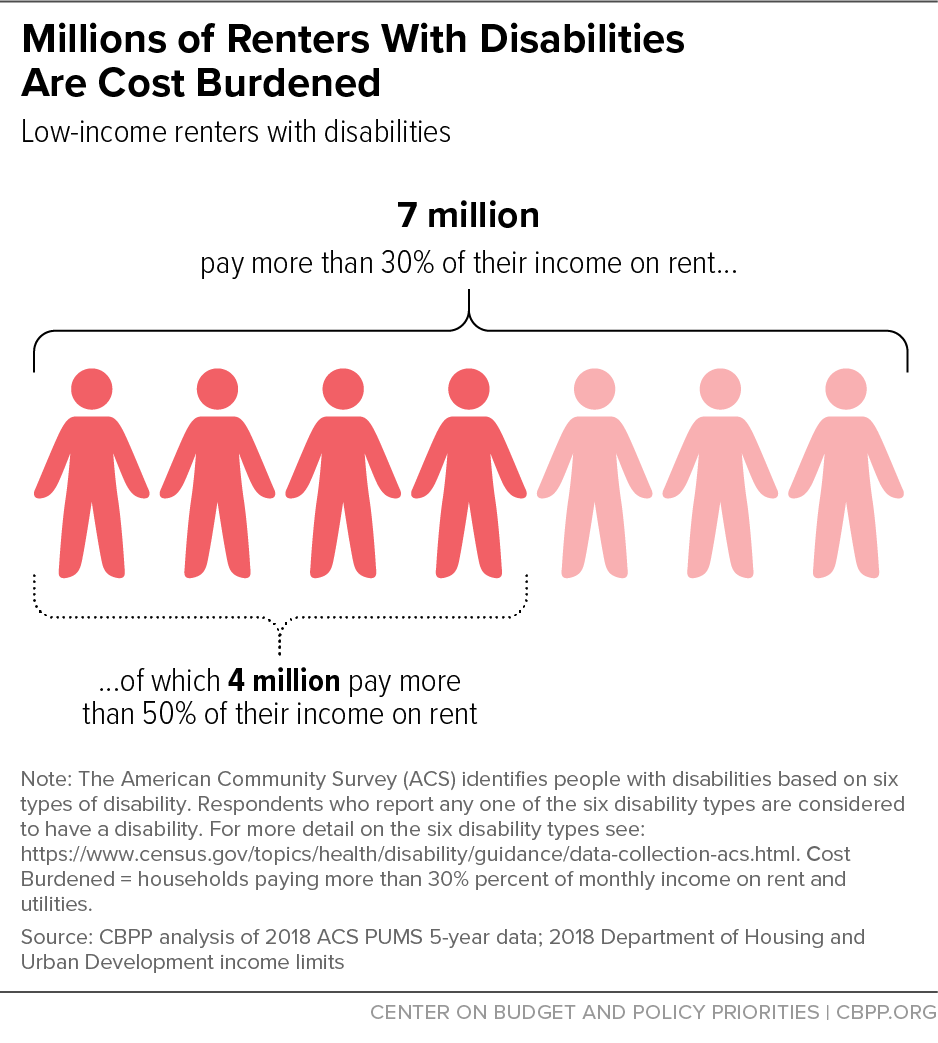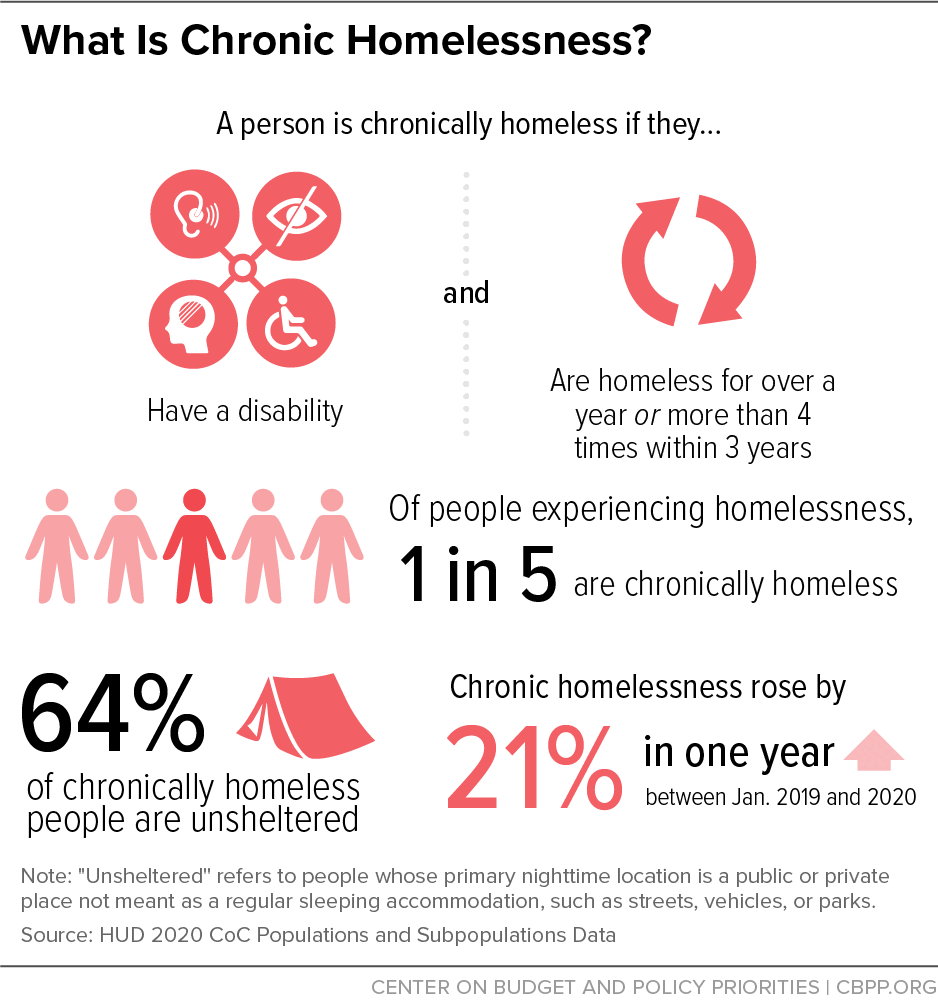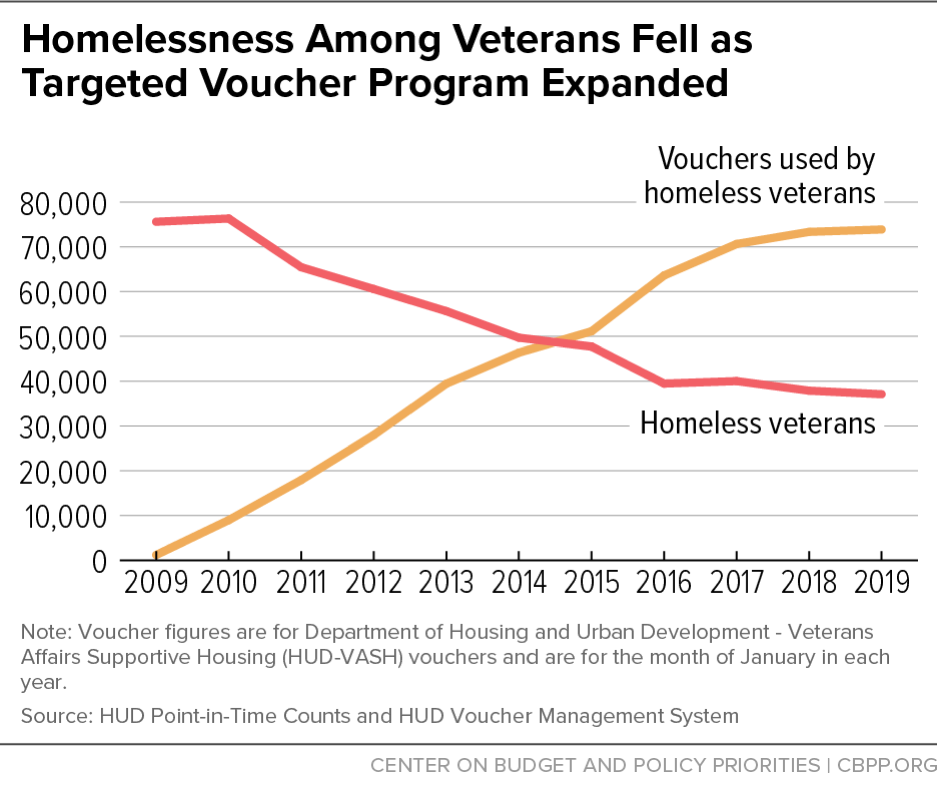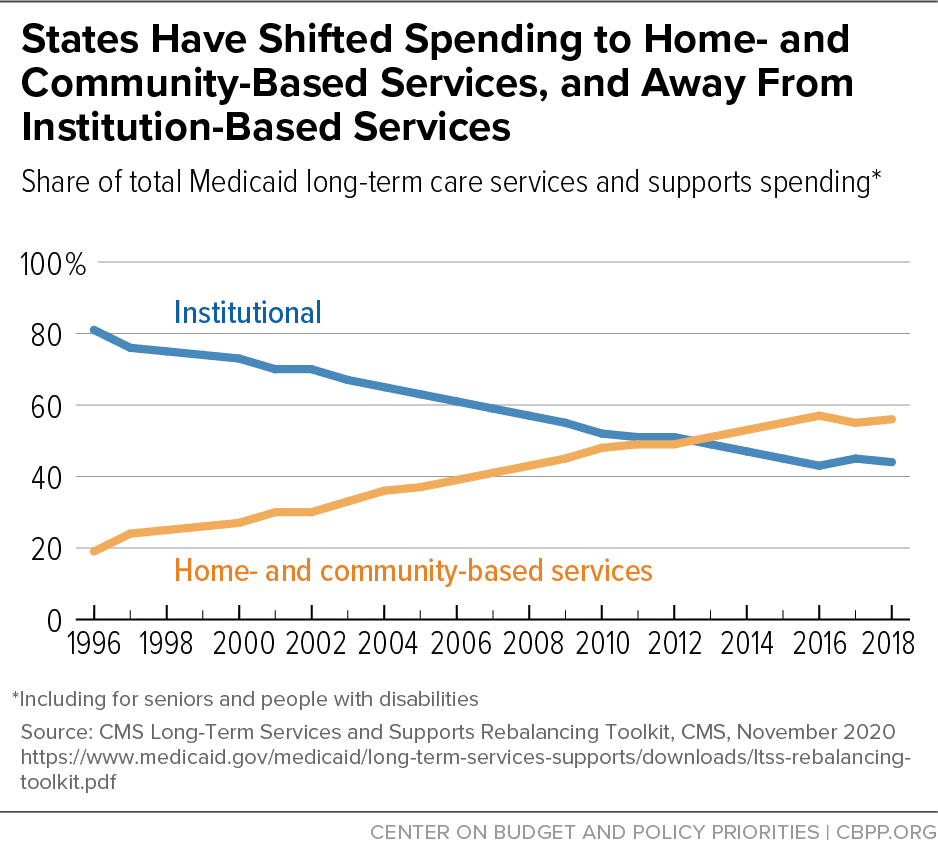Safe, affordable housing remains out of reach for millions of people with disabilities[2] and their families. Disabled people face high rates of homelessness and housing instability, which can undermine their access to health care and, in some cases, force them to live in congregate or institutional settings that undermine their independence. As Congress considers recovery legislation, lawmakers have a historic opportunity to address these problems on a long-term basis by expanding the Housing Choice Voucher program to more households.Ultimately, housing vouchers should be available to everyone who is eligible, as President Biden proposed during the presidential campaign. At a minimum, recovery legislation should make a sizeable down payment toward this goal.
Rigorous research shows that federal rental assistance is highly effective at reducing homelessness, housing instability, and unnecessary institutionalization among people with disabilities, including mental illness. But due to inadequate funding, just 1 in 4 families eligible for any type of federal rental assistance receive it, and there are years-long waiting lists for vouchers in much of the country. Unlike entitlement programs, such as Medicaid and the Supplemental Nutrition Assistance Program (SNAP), rental assistance does not expand automatically to cover all who qualify.
The severe shortage of rental assistance contributes to significant hardship for people with disabilities even in good economic times, and the effect was especially tragic during the COVID-19 pandemic and economic crisis. The lack of rental assistance left the nation ill-prepared to keep disabled people safely housed during the pandemic. Lack of rental assistance and home- and community-based services prevented many people from leaving nursing homes and other congregate settings and moving into safer, community-based settings. Meanwhile, hundreds of thousands of people with disabilities continue to live on the streets or in homeless shelters where they face additional health risks that the pandemic has exacerbated.
As the economy recovers, high rent costs will continue to create housing insecurity and hardship for millions of people with disabilities. One of policymakers’ top priorities in recovery legislation should be to provide vouchers to more families in need, including people with disabilities. Making more vouchers available would be transformative for millions of people with disabilities. Fewer disabled people would live on the street or have to choose between paying rent and buying medicine or food. More vouchers would help end poverty for millions of disabled people and would promote racial equity for disabled people of color, who face additional barriers to housing due to systemic racism and racial discrimination — especially Native Americans and Black and Latinx people. Additional vouchers could also help more people leave congregate care settings, such as nursing homes, especially if combined with the President’s proposal in the American Jobs Plan to expand Medicaid home- and community-based services, such as through the Better Care Better Jobs Act that was introduced in June.[3]
Expanding Vouchers Would Provide Economic and Housing Stability, Advance Racial Equity
Rigorous research shows vouchers are highly effective at keeping people with low incomes — including disabled people — stably housed, including by sharply reducing homelessness, housing instability, and overcrowding.[4] Vouchers typically help families rent a modest unit of their choice in the private market, meaning the family can use its voucher to rent in the neighborhood of its choice. The family pays about 30 percent of its income for rent and utilities, a widely used standard for the amount a household can reasonably be expected to pay for housing. And the voucher covers the rest, up to a cap based on Department of Housing and Urban Development (HUD) estimates of typical market rents in the local housing market.[5]
While vouchers deliver major benefits to more than 1.2 million people with disabilities nationwide (see Figure 1), they could do much more if they were made available to the millions who are eligible but unassisted due to inadequate funding.[6] Voucher expansion could make housing affordable for the more than 4 million disabled people living in households paying more than half their income on rent, including nearly half a million children with disabilities and more than 1 million disabled older adults. (See Figure 2 and Appendix Table 1 for state-by-state figures.)
By lowering rental costs, vouchers allow people to spend more on other basic needs like food and medicine,[7] as well as on goods and services that enrich their lives and support their children’s development.[8] This can help can prevent situations in which high rent costs force families to divert resources from other basic needs that can have serious consequences for the health of disabled people, such as delaying filling prescriptions or postponing health care.[9]
Making housing affordable can also prevent evictions, which can have short- and long-term health impacts, especially for women and people of color who are evicted at disproportionately high rates.[10] Preventing eviction helps families avoid the many harms of displacement, such as being forced to move into inaccessible housing, or to neighborhoods far from public transportation, health care, or social networks.[11] Eviction can cause people to miss work and lose jobs, which can compound the discrimination and health-related barriers that contribute to high unemployment rates among people with disabilities.[12] Avoiding eviction also helps reduce the frequency with which children change schools, preventing unnecessary disruption in education, including special education services for students with disabilities.[13]
Expanding vouchers would advance economic and racial equity for disabled people, who experience much higher rates of poverty than the general public. The benefits would be greatest among Black and Latinx people, who are disproportionately likely to face rent burdens due to a long history of racially discriminatory housing policies and racial discrimination.[14] Providing vouchers to all eligible households would lift 1 million people with disabilities above the poverty line, one study estimated.[15] This would cut poverty among disabled people by 25 percent, and by even more among Black and Latinx people with disabilities. (See Figure 3.)
Such an expansion would also promote a more equitable recovery from the pandemic and resulting economic crisis, which have hit families of color particularly hard and perpetuated long-standing racial disparities. While some renters with disabilities may receive short-term rental assistance enacted to respond to the pandemic and economic crisis, many will need longer-term assistance to avoid eviction after federal and local eviction bans lift and after the economy more fully recovers.
For example, over 4.4 million disabled adults under 65 receive Supplemental Security Income (SSI), but its benefits are modest — the basic monthly SSI benefit in 2021 is $794 for an individual — and, in many places, they aren’t enough to cover rent even if people allocate every dollar of their benefits to pay rent.[16] More than half of SSI recipients have no other source of income,[17] and more than 1 million people with disabilities who receive SSI live in households that pay more than half of their income toward rent. Furthermore, many disabled people who qualify for SSI don’t receive it because they have not successfully completed the arduous application process.[18] And many people with disabilities who struggle to afford rent don’t meet the strict medical or income eligibility criteria for SSI.
People with disabilities are a diverse group with a range of experiences, related both to their disabilities and to other identities, such as race, gender and gender identity, sexuality, and parental status. In this report, we generally use the term disability broadly, including, for example, mental illness, chronic physical illness, intellectual and developmental disabilities, sensory disabilities, mobility limitations, and more.
Federal and state governments apply different definitions of disability for different purposes — such as determining eligibility for legal protections or benefits. For example, the Americans with Disability Act applies a broad definition that includes people who have at least one “physical or mental impairment that substantially limits one or more major life activities.”a In contrast, the Social Security Administration applies much stricter criteria in determining eligibility for Supplemental Security Income and Social Security Disability Insurance, focusing on people whose disabilities substantially limit work.
Much of the data in this report are based on CBPP analysis of the American Community Survey (ACS). The ACS considers respondents to have a disability if they report at least one of six disability types, including: hearing difficulty, vision difficulty, cognitive difficulty, ambulatory difficulty, self-care difficulty, and independent living difficulty. However, this definition — like other definitions — may not accurately reflect the identities and experiences of all disabled people.
Expanding Vouchers Would Sharply Reduce Homelessness Among People With Disabilities
Voucher expansion is critical to ending homelessness for the hundreds of thousands of disabled people experiencing homelessness each year. A broad body of research shows that rental assistance is highly effective at reducing homelessness and helping people maintain housing stability, including among individuals with mental illness, HIV/AIDS, and other complex health conditions.[19]
Expanding vouchers would enable communities to transform the homelessness system to one that can quickly rehouse people, eventually making homelessness among disabled people a brief and rare occurrence. About half of adults — and two-thirds of veterans — living in homeless shelters reported having a disability in 2018, the most recently available data.[20] And over three-quarters of people experiencing unsheltered homelessness report having a physical or mental health condition.[21] Systemic racism compounds the barriers to affordable housing for people of color with disabilities. Native Americans, Black people, and Latinx people face higher rates of homelessness.[22]
Homelessness rates have been on the rise, even before the pandemic and economic crisis. Recent increases in chronic homelessness — repeated or long-term homelessness among people with disabilities — have been particularly large. (See Figure 4.) In 2020, more than 110,000 people experienced chronic homelessness on a single night in January, representing a 15 percent jump between 2019 and 2020 alone, and a 21 percent increase in unsheltered chronic homelessness.[23] Many communities are reporting additional increases in homelessness due to financial hardship caused by the pandemic.[24]
Vouchers can be used to create a variety of housing solutions to address homelessness, helping to ensure that people facing homelessness can choose the option that best meets their needs. For most people, rental assistance and short-term support in navigating the rental market is enough to provide long-term housing stability. However, some people need supportive housing, an evidence-based solution to homelessness that pairs rental assistance with supportive services, such as intensive case management, ongoing housing navigation, and physical and behavioral health services for those who want them.
In addition to providing stable housing, supportive housing can contribute to improved access to appropriate health care, reduced use of costly systems such as emergency health services, and prevention of incarceration.[25] This is critical as homelessness can worsen health, including exacerbating mental illness symptoms, such as depression and anxiety. For instance, it can disrupt access to care because people experiencing homelessness often lack access to reliable mailing addresses, a phone, or a computer that they need to stay in contact with health care providers. They may also lack transportation needed to get to appointments.
Vouchers have already played a major role in dramatically reducing veterans’ homelessness in recent years through the HUD-Veterans Affairs Supportive Housing (HUD-VASH) program. (See Figure 5.) HUD-VASH has ended homelessness for thousands of disabled veterans, including veterans with post-traumatic stress disorder and traumatic brain injury.[26]
Vouchers are flexible and particularly well-suited for increasing access to supportive housing. Vouchers can be tenant-based — allowing people to choose a unit on the private market — or project-based, meaning the rental assistance is attached to specific units.[27] If vouchers were readily available, this flexibility would help communities create a variety of integrated housing options — including supportive housing — so that people can choose the housing that meets their needs without being isolated from the rest of the community.[28] For instance, communities could use vouchers to create scattered-site supportive housing where tenants live in privately owned apartments throughout the community, and more project-based supportive housing that houses a mix of people who do and don’t need supportive services.
Unlike other project-based rental assistance, project-based vouchers allow tenants to move out of the unit with an available tenant-based voucher after one year (while the original subsidy stays with the unit). This provides tenants with more choice, ensuring that they do not risk losing housing assistance if they wish to live somewhere else and letting them move out of project-based supportive housing if they no longer need it. If vouchers were available to everyone who is eligible, supportive housing residents could use a voucher to seamlessly move to a different setting whenever they choose to, which would subsequently open another slot for someone who needs and wants those intensive services.
Expanding Vouchers Would Help More People Live in the Community
Housing Choice Vouchers are a particularly important tool for helping renters with disabilities lead the lives they envision, including by helping people to live in the community instead of institutional settings. Despite significant progress in increasing access to home- and community-based services (HCBS), many people who could live in the community if the right services were available continue to live in congregate care settings, where they are more isolated from the rest of the community. The lack of affordable, accessible housing is a key barrier to helping more people transition out of institutional settings and into their own homes.
The federally funded Money Follows the Person (MFP) demonstration provides enhanced federal Medicaid matching funds for transition-related services during the first year after an eligible individual moves from an institution to a community-based setting. States use MFP in a variety of ways to facilitate such transitions, including coordinating services, locating housing, and paying for home modifications needed to make housing accessible. The program has successfully helped over 100,000 Medicaid beneficiaries in 44 states transition from institutions into community-based settings since 2007.[29] MFP participants report significantly improved mental health, community integration, and a reduction in unmet personal care needs (such as eating and bathing) after transitioning to the community.[30] More than one-third of MFP participants have moved into a rental unit,[31] and while no data are available regarding participants’ usage of rental assistance, MFP program evaluators expect that most participants who moved into a rental unit needed rental assistance to afford it.[32]
But far more people are eligible for MFP than have been able to participate to date. One estimate found that more than 1 million Medicaid enrollees may have been eligible for MFP in 2011.[33] Lack of affordable housing, inadequate funding for HCBS, and uncertainty about continued funding for MFP have limited the number of people the demonstration has served. State officials and researchers commonly cite lack of rental assistance — including vouchers — as a key barrier preventing many of the people eligible for MFP services from transitioning out of institutions and into a rental home.[34] For example, in 2015, Colorado officials reported that about 75 percent of people who expressed interest in MFP could not participate due to lack of affordable housing.
During the pandemic, the lack of affordable housing and HCBS — such as services that help people prepare meals, dress, work, or remember and attend appointments while living in the community — contributed to large numbers of people with disabilities being unnecessarily exposed to the coronavirus while living in institutional care settings, in congregate shelters, or on the streets, causing preventable loss of life. In fact, long-term care facilities account for 5 percent of total reported COVID-19 cases and nearly one-third of deaths, the most recently available data indicate.[35]
Voucher expansion could help many disabled people who want to live in the community move out of nursing homes, psychiatric facilities, and other congregate facilities, especially if paired with more funding for Medicaid HCBS, as proposed in the President’s American Jobs Plan and as described later in this paper. People who use vouchers to move out of institutions may also be less at risk of contracting COVID-19, the flu, and Clostridium difficile (commonly known as C. diff), and other contagious illnesses, in addition to improved quality of life.[36]
Voucher expansion could also provide a safety net for many people with disabilities who are currently stably housed while living with family but could be at risk of institutionalization in the future if their housing circumstances change. For example, more than 800,000 people with intellectual and developmental disabilities are estimated to live with a family caregiver over the age of 60, such as a parent.[37] As family caregivers age, they may no longer be able to ensure their loved one has stable housing. Without rental assistance, many people who could otherwise continue living in the community may be forced into congregate care facilities.
Inclusive, affordable housing means people with disabilities can live in neighborhoods that best meet their needs, such as near key community resources, services, or social supports that reduce isolation and barriers to community living. For example, some people who use mobility aids such as wheelchairs may want to live near schools or jobs and in neighborhoods with quality, accessible sidewalks. People who receive daily in-home care may wish to live near their caretakers. And someone who has frequent health care visits — such as mental health counseling or dialysis —may want to live near public transportation that makes it easier to get to appointments.
Vouchers may be particularly important for disabled people of color who often face even more limited housing choice due to a long history of discriminatory policies that created and continue to reinforce the racial segregation of low-income people — particularly Black families.[38] While fair housing enforcement and other tools are also needed to promote housing choice, vouchers can make it easier for people of color to live in the neighborhood of their choice.
Voucher expansion can have an even greater impact in promoting choice and inclusion alongside other important policy improvements and investments that broaden housing choice. For example, research shows that small area fair market rents — which base voucher assistance levels at the neighborhood rent level instead of entire metro areas — help families exercise more choice over where they live and make the voucher program more cost effective.[39] And while some cities and states have prohibited landlords from denying housing to people solely because they have a voucher or receive Supplemental Security Income, source-of-income discrimination is legal in most communities.[40] Easing restrictions on voucher eligibility for people affected by the legal system — such as people with a past arrest or conviction — can also improve access to affordable housing for disabled people, who are disproportionately represented in jails and prisons.[41]
Affordable housing development and rehabilitation is needed to ensure that housing is not only affordable but also accessible for people with disabilities. The Administration proposed these types of investments in the American Jobs Plan announced on March 31, specifically calling for over $300 billion in investments to build or renovate affordable housing — including $40 billion for public housing.
Less than 2 percent of the housing stock was accessible to people with limited mobility in 2011, HUD estimated.[42] Less than 12 percent of renters with mobility limitations live in units that are “livable,” and less than 1 percent live in a wheelchair-accessible home. However, much of the housing stock — including over 40 percent of units rented by people with disabilities — could be modified to become accessible were funding available. Affordable housing development and rehabilitation funding is also important for creating more units that are accessible for people with sensory disabilities, including Deaf or blind people.
Many longstanding policies that direct resources to people and communities were adopted within an ableist culture that reflected the belief that disabled people are inherently inferior or less important members of society. Examples include the once-common practices of mass institutionalization and forced sterilization of people with disabilities, which continued well into the second half of the 20th century and were long upheld by U.S. courts.a
The disability rights movement has won significant victories — including the enactment of the Americans with Disabilities Act (ADA) and the Fair Housing Act Amendments of 1988 — that greatly improved access to community-based housing and services, employment, education, and public services and spaces. But discrimination remains common; more than half of all housing discrimination complaints cite disability discrimination.b More is needed to fulfill the promise of civil rights laws, and today’s policies can still perpetuate or worsen longstanding inequities even if they are not explicitly discriminatory.
Policies can have negative effects on disabled people if they ignore the history of governmental and private actions that created and perpetuate the segregation and exclusion of disabled people. The underinvestment in federal rental assistance — including vouchers — is one such policy. While seemingly disability-neutral, the decision to not fully fund rental assistance (and home- and community-based services) has the effect of keeping hundreds of thousands of people with disabilities in segregated care settings or leaving many without any home at all. So, while the Supreme Court’s 1999 Olmstead v. L.C. decision holding that the ADA requires states to serve people with disabilities in the most integrated setting of their choice has helped make progress, the legacy of forced institutionalization remains intact.c
Lack of investment in affordable housing also compounds the harms caused by additional inequities that many disabled people face, including systemic racism. The policies that created and maintain racial segregation further limit choices for Black and Latinx people with disabilities about where they live. Structural racism in other areas of life, such as employment and education, also makes it harder for disabled people of color to live the life they envision and it contributes to disparities. For instance, people with disabilities as a whole experience higher poverty and lower employment rates than the general public, and disparities are even worse for Black people with disabilities.d
a See Alexandra Minna Stern et al., “California’s Sterilization Survivors: An Estimate and Call for Redress,” American Journal of Public Health, January 2017, https://www.ncbi.nlm.nih.gov/pmc/articles/PMC5308144/.
b Lindsey Augustine et al., “Fair Housing in Jeopardy: Trump Administration Undermines Critical Tools for Achieving Racial Equity,” National Fair Housing Alliance, September 2020, https://nationalfairhousing.org/wp-content/uploads/2020/09/NFHA-2020-Fair-Housing-Trends-Report.pdf.
c Bazelon Center for Mental Health Law, “The Olmstead Case,” http://www.bazelon.org/the-olmstead-case/.
d Nanette Goodman, Michael Morris, and Kelvin Boston, “Financial Inequality: Disability, Race and Poverty in America,” National Disability Institute, September 2017, https://www.nationaldisabilityinstitute.org/wp-content/uploads/2019/02/disability-race-poverty-in-america.pdf.
However, a housing investment package that excludes vouchers and focuses solely on development would fail to make housing affordable for most disabled people with the lowest incomes.[43] Supply-side investments alone can’t create enough housing that’s affordable for people with incomes near the poverty line, including millions of people who receive SSI. Rents are still out of reach for people with extremely low incomes in the large parts of the country where the housing supply is adequate. Vouchers are much more cost-effective than new construction in these areas. And capital subsidies to renovate or build housing alone generally do not produce housing with rents that are affordable to the lowest-income renters unless they receive a voucher or similar assistance, because the ongoing costs of maintaining the building far exceed the rents that low-income families can afford. A supply-side only approach would also limit the housing choices available to people with disabilities. Development-based subsidies help families to rent a particular unit, but they usually have to give up their subsidy to move elsewhere (for example, to be close to health care, jobs, caregivers, or schools).
Expanding Access to Home- and Community-Based Services Is Also Needed to Help More People Live in the Community
Voucher expansion has immense potential to help people with disabilities and low incomes live the life they envision. However, some disabled people also need individualized, long-term services and supports in their homes to remain stably housed in the community. For instance, some people need assistance with preparing meals, getting dressed, working, or remembering and attending appointments. These home- and community-based services are typically not covered by private health insurance or Medicare and are often unaffordable for people with disabilities who have low incomes.
Medicaid provides health coverage to millions of Americans with disabilities with low incomes and is the main source of coverage for HCBS. Today, Medicaid provides HCBS to nearly 5 million seniors and disabled people, and more than half of Medicaid spending on long-term services and supports is for services provided in the community rather than institutions.[44] (See Figure 6.) However, unlike nursing home care, state Medicaid programs are not required to cover HCBS. States can use HCBS “waivers” to provide a package of HCBS that are specifically designed for groups with particular kinds of disabilities, such as people with intellectual and developmental disabilities, seniors with physical disabilities, or people with traumatic brain injury. States can also restrict services to people with certain levels of needs, limit the kinds of services covered, and cap the number of slots available. This allows states to manage the costs of providing HCBS, but it results in uneven coverage for HCBS.[45]
States select which services to offer under their HCBS programs, and the programs vary significantly across states. For instance, states vary widely in their coverage of peer support (such as services delivered by people with lived experience of substance use recovery), supported employment services that help people succeed in the competitive job market, and tenancy support services. Pre-tenancy and tenancy support services help people with disabilities secure adequate housing, advocate for reasonable accommodations, and avoid eviction.[46] (Medicaid funds cannot go toward recurring costs of room and board, such as rent.)
States can also limit how many people receive HCBS at a time. People who need HCBS but are unable to get them through Medicaid may forgo care, accumulate medical debt to pay for services, or remain in or move into a congregate care setting. Most states create waiting lists when the services slots for HCBS waiver programs are filled. It was estimated that in 2018 almost 820,000 people nationwide remained on HCBS waiting lists.[47] But these lists are an incomplete measure of unmet need for HCBS and state capacity to provide more services, and each state’s waiting list is unique.[48] Waiting lists reflect the degree to which a state has chosen to dedicate resources to HCBS and whether they screen to determine whether someone is qualified for waiver services before placing them on the list or wait to do so until a slot opens. States without waitlists or that report zero people on their waitlists still almost certainly have large unmet need for HCBS.
The Better Care Better Jobs Act, introduced in the Senate in June, follows up on President Biden’s proposal in the American Jobs Plan to improve access to HCBS, strengthen the direct care workforce, and extend MFP, which is currently funded through 2023. Such an investment would be a critical step toward expanding HCBS for all low-income people who need them. More federal funds for HCBS are needed to expand services and strengthen the caregiving workforce, and will help states attract and better train caregivers, improve working conditions, and provide higher pay. These improvements would build on the 10 percentage-point increase in the federal Medicaid matching rate for HCBS (available through March 31, 2022, for states that enhance, expand, or strengthen HCBS) included in the American Rescue Plan Act enacted in March.
However, investing in additional HCBS without also ensuring access to affordable housing could leave behind many disabled people with the lowest incomes and greatest barriers to living in the community. Since many seniors and people with disabilities (including many who rely mainly or entirely on SSI) do not have enough income to afford rent, some may be forced to remain in institutional settings and unable to use the expanded services. Others could be forced to pay such high shares of their income for rent that they would be at risk of hardship — such as eviction, homelessness, food insecurity, and utility shutoffs — that could jeopardize their health and access to HCBS. Increasing funding for HCBS and vouchers is critical for promoting equitable access to community-based living for all people with disabilities.
| APPENDIX TABLE 1 |
| |
Under 18 |
18-64 |
65 and Over |
Total People With Disabilities |
| Alabama |
7,000 |
40,000 |
11,000 |
58,000 |
| Alaska |
N/A |
6,000 |
1,000 |
8,000 |
| Arizona |
9,000 |
46,000 |
21,000 |
77,000 |
| Arkansas |
6,000 |
28,000 |
8,000 |
42,000 |
| California |
58,000 |
304,000 |
191,000 |
553,000 |
| Colorado |
7,000 |
38,000 |
17,000 |
62,000 |
| Connecticut |
6,000 |
28,000 |
14,000 |
47,000 |
| Delaware |
N/A |
4,000 |
2,000 |
8,000 |
| District of Columbia |
2,000 |
10,000 |
3,000 |
15,000 |
| Florida |
31,000 |
145,000 |
85,000 |
261,000 |
| Georgia |
17,000 |
79,000 |
27,000 |
123,000 |
| Hawai’i |
2,000 |
9,000 |
5,000 |
16,000 |
| Idaho |
2,000 |
11,000 |
4,000 |
17,000 |
| Illinois |
14,000 |
88,000 |
46,000 |
148,000 |
| Indiana |
10,000 |
53,000 |
18,000 |
81,000 |
| Iowa |
2,000 |
18,000 |
9,000 |
29,000 |
| Kansas |
4,000 |
21,000 |
9,000 |
34,000 |
| Kentucky |
9,000 |
47,000 |
11,000 |
67,000 |
| Louisiana |
9,000 |
40,000 |
12,000 |
62,000 |
| Maine |
2,000 |
12,000 |
4,000 |
18,000 |
| Maryland |
10,000 |
38,000 |
19,000 |
67,000 |
| Massachusetts |
11,000 |
60,000 |
30,000 |
101,000 |
| Michigan |
15,000 |
88,000 |
32,000 |
135,000 |
| Minnesota |
5,000 |
32,000 |
25,000 |
62,000 |
| Mississippi |
6,000 |
25,000 |
6,000 |
37,000 |
| Missouri |
9,000 |
52,000 |
17,000 |
79,000 |
| Montana |
N/A |
7,000 |
4,000 |
11,000 |
| Nebraska |
2,000 |
11,000 |
7,000 |
20,000 |
| Nevada |
4,000 |
29,000 |
13,000 |
46,000 |
| New Hampshire |
2,000 |
10,000 |
4,000 |
16,000 |
| New Jersey |
14,000 |
59,000 |
38,000 |
111,000 |
| New Mexico |
3,000 |
17,000 |
5,000 |
25,000 |
| New York |
37,000 |
192,000 |
118,000 |
347,000 |
| North Carolina |
15,000 |
81,000 |
29,000 |
124,000 |
| North Dakota |
N/A |
4,000 |
3,000 |
7,000 |
| Ohio |
23,000 |
111,000 |
39,000 |
173,000 |
| Oklahoma |
6,000 |
31,000 |
10,000 |
47,000 |
| Oregon |
7,000 |
42,000 |
20,000 |
69,000 |
| Pennsylvania |
25,000 |
110,000 |
49,000 |
184,000 |
| Rhode Island |
2,000 |
11,000 |
5,000 |
18,000 |
| South Carolina |
7,000 |
37,000 |
13,000 |
56,000 |
| South Dakota |
N/A |
4,000 |
4,000 |
9,000 |
| Tennessee |
11,000 |
61,000 |
18,000 |
90,000 |
| Texas |
43,000 |
162,000 |
77,000 |
282,000 |
| Utah |
3,000 |
13,000 |
5,000 |
21,000 |
| Vermont |
N/A |
6,000 |
2,000 |
8,000 |
| Virginia |
11,000 |
52,000 |
24,000 |
87,000 |
| Washington |
9,000 |
61,000 |
29,000 |
99,000 |
| West Virginia |
2,000 |
17,000 |
3,000 |
23,000 |
| Wisconsin |
8,000 |
42,000 |
23,000 |
73,000 |
| Wyoming |
N/A |
4,000 |
1,000 |
5,000 |
| Total U.S. |
493,000 |
2,496,000 |
1,170,000 |
4,158,000 |
